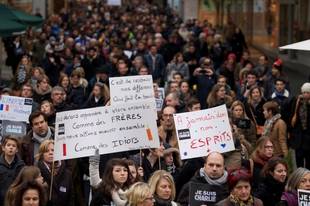
A social movement develops once collective behaviour persists and becomes organized.
Keller (1982) defines social movement as an interrelated and co-acting unity of persons with some degree of organizational continuity aimed to promote or resist change in the society of which it is a part. It is directed toward the change of the established norms, values, or social structures.
Social movement refers to an interested and motivated gathering of people which aims to modify or change the society’s structure or ideology in a concerted and deliberate manner. It seeks to establish changes or reforms to promote a new social order with new norms, new values and new goals. It challenges the existing social order.
Examples: Women’s Liberation Movement; Environmental Protection Movement.
Comparison of Collective Behavior and Social Movement
Collective behaviour refers to relatively non-routine actions that engage large, often anonymous, groups of people. It entails episodes of behaviors that differ from the more habitual, repetitive behaviors that characterize our daily lives. It does not follow the established norms and patterns of behaviour.
Social movement, on the other hand, is another form of social behaviour which also occurs outside the institutional framework of our everyday life. It is a “conscious, collective, organized attempt to bring about or resist large-scale change in the social order by non-institutionalized means (1973, Wilson)”
Mark Traugott (1978) has agreed that collective behaviour and social movement are separate phenomena. Whereas collective behaviour is characterized by spontaneity and lack of internal structure, social movements have a high degree of internal order and a sustained, purposeful orientation. They are highly structured, have well-defined statuses and norms, endure for many years, and have well-established goals.
Types of Social Movements
David Aberle (1966) classified social movements on the basis of two criteria: (1) the type of change their sponsors seek (either a change in the individuals or a change in the social order); and (2) the amount of change they seek (either partial or total). They are of four types:
1. Alternative Movements
Refer to movements that aim to achieve some limited but specific change in individuals. Examples: religious movements on morality and ethics, Alcoholics Synonymous Women’s Liberation Movement; Gay Liberation Movement
2. Redemptive Movements
Refer to movements that also focus on the individual, but they seek total, not partial change. Examples: Christian Movements; Couples For Christ
3. Reformative Movements
Refer to movements that emphasize changing society rather than individuals. Their aim is moderate or partial change since they view the present social order as basically workable. Examples: Civil rights movement; human rights movement; Propaganda Movement, Kilusang Bagong Lipunan
4. Transformative Movements
Refer to movements that aim at total change in the existing social order. There is a need to re-structure or to completely overhaul the existing structure which members perceive as unjust, exploitive and anti-people’s well being. Transformative movements are true revolutions. Examples: Bolshevik Revolution in Russia; the Philippine Revolution of 1896; the French Revolution.
Mass Communication
1. Meaning and Nature of Mass Communication (Mass Media)
Mass communication refers to an organized communication through organizational structures. It is directed towards a relatively large audience during a short period of time or even instantly (Wright 1984).
Collective behaviour and social movements depend heavily on mass communication among many people. The emergence of mass media has greatly increased the number of people exposed to collective action and the amount of information (or misinformation) conveyed to them.
2. Forms of Mass Media
The mass media include:
a. Print
- Newspaper
- Magazines
- Tabloids
- Journals
- Pamphlets/Leaflets
b. Electronic/Broadcast
- Radio
- Television
- Motion picture
- Computer
- Internet
- Audio and video tapes
3. Roles of Mass Media
The mass media perform the following roles:
- To provide information to a large number of people
- To provide education to the masses
- To provide entertainment
- To clarify/ventilate issues and concerns
- To serve as avenues for propaganda
- To provide avenues for expression of partisan and non-partisan ideas.
- To generate public opinion or call for collective behaviour and social movements.
- To serve as a vehicle for the expression of aroused feelings, pent-up emotions and redress of grievances.
Social Consequences of Collective Behavior and Social Movements
Panopio (2004) gives the following social consequences of collective behaviour and social movements:
- Collective behaviour becomes a vehicle for the release of aroused feeling, accumulated tensions, anxieties, and discontent.
- Collective behaviour and social movements can contribute to social change and improvements. They can result in wage increase and the granting of benefits, new pieces of legislation, replacement of public officials, and popular endorsement of new values or strengthening of values extolled.
- Social movements lead to some basic changes in the social structure and policies. Examples: labor movements, human rights movement, students movement, women’s movement; anti-nuke movement
- Social movements may result in new institutions with new and radical values, or in the preservation of the social order. Example: reform movement and revolutions.
- Collective behaviour and social movements may result in new directions of the culture and the establishment of new folkways, mores, and values.

















